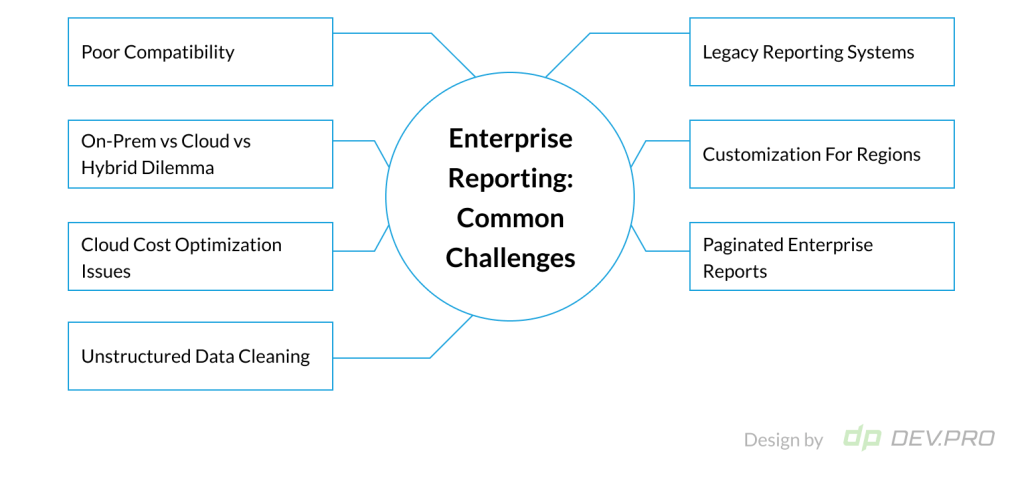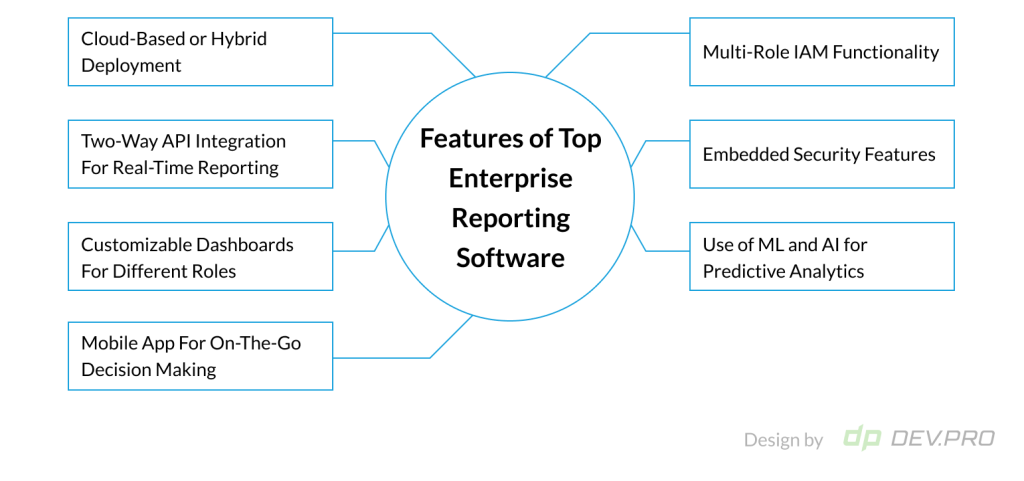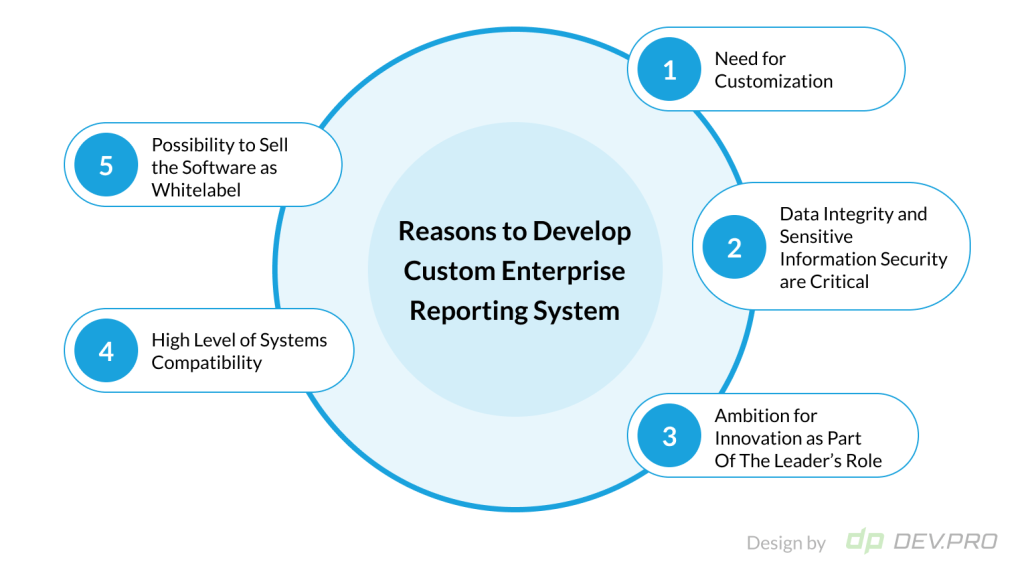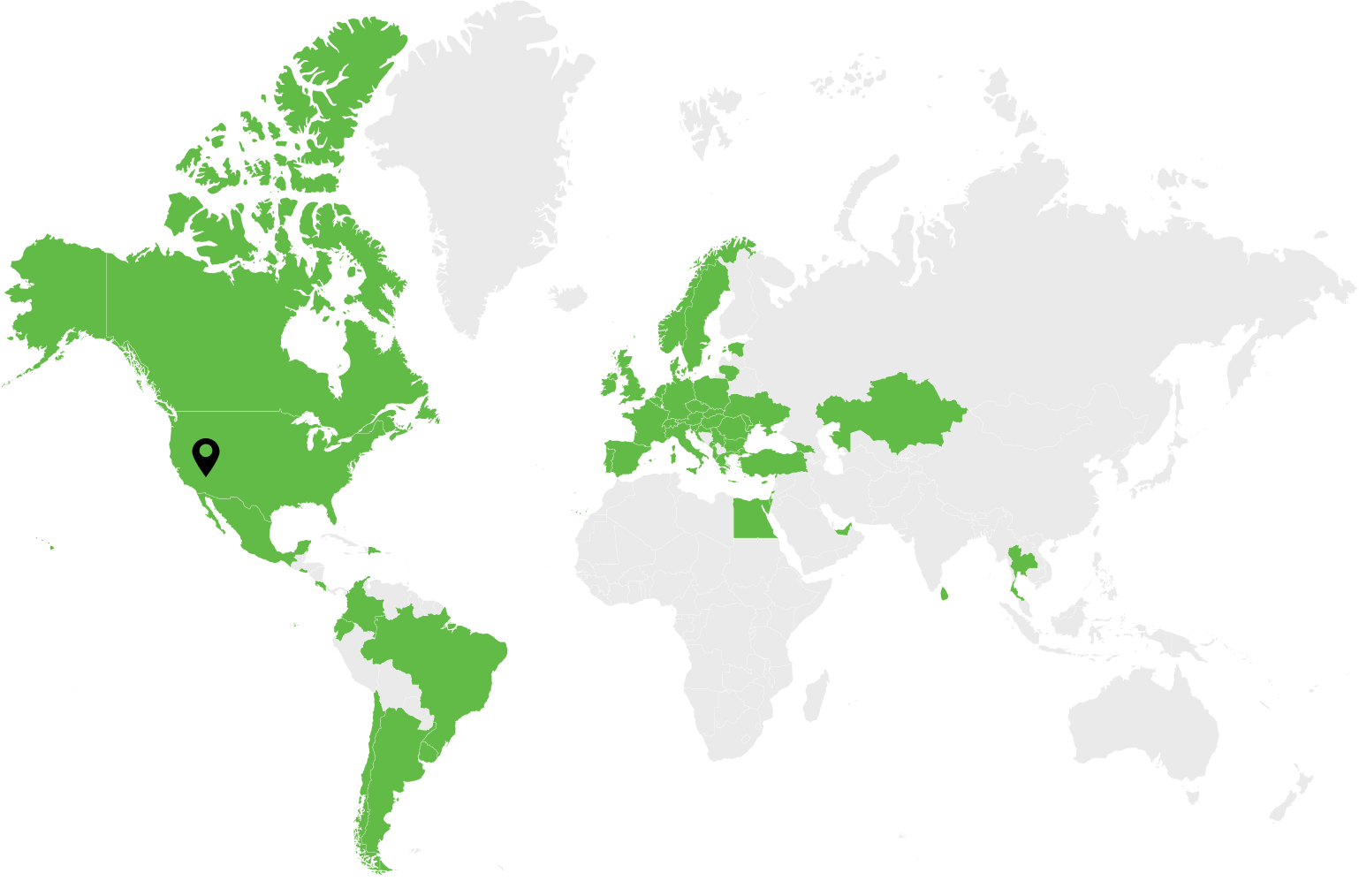Enterprise reporting is an integral part of the Data Analysis and Business Intelligence domains. It’s an existing ecosystem in most enterprises in some form. Some are as basic as a few Google Sheets connected to a free version of a reporting SaaS system, while others are custom multi-tenant software solutions with interactive and self-service reporting modules.
At different stages of development of a company’s life cycle, its enterprise reporting architecture evolves to match its business needs. At the beginning, this architecture helps balance costs. Later, it reveals how to tune the product to better fit client requirements, while mature enterprises get strategic insights for future development based on predictive analytics.
The global market size of the business intelligence and analytics software applications industry will reach $15.7 billion in 2021, according to Statista. Not only does the growth illustrate the booming demand, but it also signals the number of businesses that enjoy positive ROI from the technology.
Let’s review the major features and trends on the topic, so as to arm our readers for the optimal use of reporting software solutions: on the enterprise level or for a small scaleup of just ten team members.
What is an Enterprise Reporting System?
Before getting down to the major issues in enterprise reporting and ways to overcome them, let’s define the term:
Enterprise Reporting System is a network of interconnected tools that collects, cleans, processes, visualizes, and distributes data. It’s closely related to BI, business analytics and reporting terrain, but is mostly focused on descriptive and diagnostic use of analytics.
These systems may have the following components:
- Excel and Google Sheets – any Data Silos
- CRM [Customer Relationship Management]
- ERP [Enterprise Resource Planning]
- Accounting, HR, and marketing software solutions
- Databases
- API
- Data Warehouse
- ETL tools [Extract Transform Load]
Due to the multitude of elements in this network of instruments, compatibility, two-way sync, API connectivity are important in both cases: for developing a custom Enterprise Reporting software [ERS] solution or integrating disparate vendor-made solutions.
Common Problems with Enterprise Reporting
When building enterprise reporting systems, many companies face similar challenges.
Compatibility
It takes a veteran software development architect to devise an enterprise reporting architecture that can be integrated with one another in a two-way sync manner. The complexity of the structure can be reinforced by a combination of legacy software and cloud solutions, multi-vendor cloud systems, and long-term contracts.
On-Prem vs Cloud vs Hybrid
While components that feed data into the reporting module are located on different hosting environments, this adds extra complexity for system integration engineers.
Cloud Cost Optimization
This next issue is related to the one above and is a hot topic for an increasing number of software product companies that use cloud services. Right-sizing and right-costing measures will eventually become a routine standard operating procedure, but at this early adoption stage of the concept only a few know how to approach this challenge.
Our FinOps white paper will help get a good grasp on the subject in under 10 minutes.
Structured vs Unstructured Data
There’s a lot of unstructured data that needs to be analyzed, like Facebook comments, videos, or social media sentiment metrics. Integration of such data is administered with the help of third-party tools that use machine learning, Artificial Intelligence, Neuro Linguistic Processing, cognitive agents, and other modern technologies to make it part of the structured data eventually.
Legacy Reporting Systems
People don’t take to new tech too willingly and any innovation in the working environment is likely to meet some extent of corporate resistance. Moreover, many companies will have a transition period when they use a legacy system with a new technology for an extended time.
Customization
Customization and ability to generate tailor-made reports from different sources is vital for a successful integration of the enterprise reporting system.
Paginated Enterprise Reports
It can be hard to fit a large amount of data onto a single 8.5 x 11in page.
Paginated reports are intended to fit on a page so that colleagues can print them and share. In ready-made reporting software solutions, these features usually come in premium subscription, while companies looking to develop a custom reporting system should include this in the project requirements.

What is a Good Enterprise Reporting Software?
If you decide to develop a custom-made enterprise reporting ecosystem or opt for a mix of out-of-the-box solutions, these criteria are a solid foundation for any quality analytical system.
Cloud-Based or Hybrid
Cloud brings flexibility, scalability, and security for any software system, but when it comes to analyzing big data and storing lots of idle historical information for compliance, audit and research purposes, cloud is a must-have. If you need to use legacy on premise deployment, hybrid solutions offer the best of both worlds.
Two-Way API Integration For Real-Time Reporting
Enterprise reporting architecture may spread across continents, departments, affiliates, and systems from different suppliers. Two-way API integration is a vital characteristic that enables the company to sync data in real-time for data-driven decision-making.
Customizable Dashboards
Customization can be symbolic, like getting rid of overly technical KPIs from the main dashboard when you deliver a report to the c-suite. It can also be as pivotal as adopting the interface to the symbol-based languages, like Japanese, for international branches.
Mobile Application For On-The-Go Decision Making
Many junior and senior personnel work in sales, construction, and healthcare. Access to information needs to be uninterrupted even if such professionals are on the go.
Multi-Role IAM Functionality
Multi-level identification and access management protects the confidential data from unauthorized personnel, as well as protects all users from analysis paralysis.
Embedded Security Features
Storing confidential data away from the prying eyes, encrypting the PII, and using private servers for storing passwords are all good signs your database is going to serve you and not your competitors.
Use of Machine Learning and Artificial Intelligence for Predictive Analytics
In fast-paced environments like retail, eCommerce, logistics, and supply chain, getting your hands on the trends to forecast and plan your activities is the revenue-generating activity of many leaders today. ML and AI help turn big data into predictions of business trends.

How to Develop an Enterprise Reporting Strategy
While the term “enterprise” suggests a larger company with possibly a few branches, and departments, each industry will have its particulars in software systems used. Let’s review some common steps for implementing an enterprise reporting system, which are valid for the majority of bigger businesses out there.
Planning Stage
- Organize a committee or CoE of analytics and reporting system implementation to include: product owner, sales, marketing, finance, HR, purchasing, legal, IT, and operations.
- Conduct an inventory of existing reporting files, systems, processes, vendors, and subscriptions.
- Conduct inventory of reporting and analytical needs by department, period, region, and roles. Pay attention to mission-critical real-time reporting.
- Investigate the best practices of implementation of the enterprise reporting system in your organization, industry, country, and global leaders.
- Discuss and define budgets, timelines, people responsible for design and development of the enterprise-wide reporting and analytical solutions.
- Create a roadmap and/or gantt chart to include high-profile estimates:
- Timeline
- Features
- Budgets
- Vendor preference
- Draft the RFP based on above criteria and collect possible solutions as offered by enterprise software development companies. Review results and choose a solution.
Design and Architecture Stages
- Based on deliverables from the planning stage, identify the project leader and the team – be it an internal resource or an outside system integration service supplier.
- Design a first draft of the architecture of the future company reporting system to include cloud services, databases, list of departmental software and sheets to be used as data sources, data warehouse, and ETL tools.
- Request an RFP from a few alternative suppliers for all services and products you’ll require with their vision of architecture based on your input and requirements.
- Finetune the architecture of the reporting ecosystem based on the final selection of tools, programming languages, cloud service suppliers, and third-party vendors.
- Adjust the roadmap of the project gantt chart according to the new data and approve with decision makers.
Development Stage
- UX and UI processes will help define the layout of each report, including its data sources, recipients, frequency of formation, and automation.
- According to the flow of the development, deployment environments used and other system requirements the development, testing and deployment stages are rolled out.
- CI/CD practices are the best for systems with real-time reporting needs and high-volume big data analytics.
- Testing and QA takes place alongside continuous integration and deployment.
The maintenance and update stage follows the testing and rollout of the system, during which time new reports are added and old ones are tuned according to your business’s needs.
Why Do You Need a Custom Enterprise Reporting System?
SaaS solutions make it possible to access a ready-made reporting and analytics functionality at a monthly subscription without an upfront investment.
However, consider these advantages of custom-made enterprise reporting systems:
- Customization
The privilege of having exactly the features needed for your business and having no irrelevant features that clutter the screen and complicate the process.
- Data Integrity and Sensitive Information Security
Data is the core value of businesses because decisions are based on real-time KPIs. Keeping it secret inside an organization is a competitive advantage.
- Innovation as Part of the Leader’s Role
Leaders cannot wait until the vendor arrives at the decision to change a feature, they need to set an example and be the innovators and early adopters of every new technology.
- High Level of Systems Compatibility
If you plan your reporting ecosystem from scratch, you ensure all tools are compatible with each other.
- Possibility to Sell the Software as Whitelabel
Once a software solution is created, it can be further sold for profit — as is, or some option of it.

Tech Stack to Create a Custom Reporting System
Dev.Pro has extensive experience in developing enterprise reporting software solutions with pagination, internationalization, data exports from multiple sources, automation, and visualization features among others.
This is the tech stack our data scientists, business analysts, and software engineers commonly use for the job:
Backend: Node.js (Koa); ETL: Scala, Spark, Python, EMR, AWS Data Pipeline; BI: SSRS; Database: MongoDB, Redis, AWS Redshift; Frontend: Apollo GraphQL, Cordova, Ionic, Angular, React, TypeScript, Vega, Redux.
Now that you’ve been exposed to enough technicalities, the DevPro team will be delighted to provide further answers for your particular case. Just send us your questions.
Achieve Your Goals with an Enterprise Reporting System
If your company is growing, or if you’re thirsty for data to drive decision-making, it’s time to consider an upgrade.
Finding the right data at the right time in the right hands is a solid tool that can help a company meet major goals. Good data can help your company drive market share, reduce costs, increase revenues, boost client loyalty, and manage labor more efficiently.
If you need more information on how to create a paginated internationalized reporting system for your enterprise, refer to our team for our best offer for your case.

